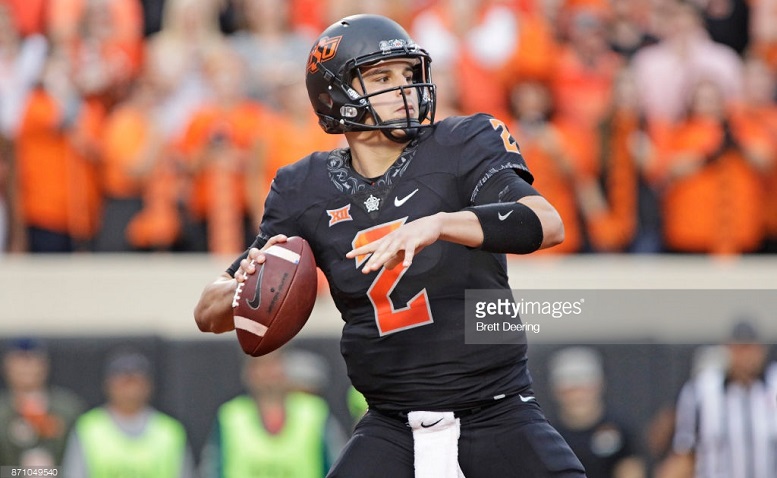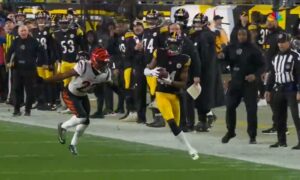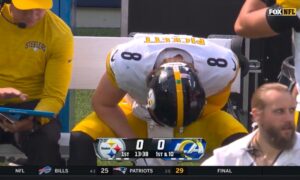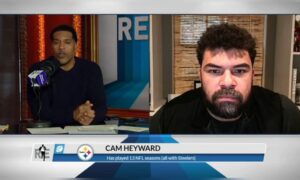From now until the 2018 NFL Draft takes place, we hope to showcase as many prospects as possible and examine both their strengths and weaknesses. Most of these profiles will feature individuals that the Pittsburgh Steelers are likely to have an interest in, while others will be top-ranked players. If there is a player you would like us to analyze, let us know in the comments below.
#2 Mason Rudolph / QB / Oklahoma State: 6’4”, 235lbs
The Good:
– Prototypical size
– Good rhythm and balance in his drops, sets (and resets) feet quickly
– Strong and difficult to bring down in the pocket.
– Tight, over-the-top release; able to “throw from inside a phone booth”
– Keeps a balanced, wide base while surveying the field
– Consistent accuracy and ball placement
– Great passer in the short game
– Good decision maker: did not force many passes into bad situations
– Consistent ball security in the pocket; keeps both hands on the ball
– Reads defenses well (although he faced fairly simplistic schemes in the Big 12)
– Takes what the defense gives him
The Bad:
– Played in a QB-friendly spread system; inexperienced in a pro-style scheme
– Slightly statuesque: can be heavy-footed when sliding in the pocket; can improve lateral quickness
– Tends to have slightly too much weight on his back foot when throwing, but not horrible
– Never took snaps from under center
– Might need to rework his drop back since he initiates his drop with the wrong foot when in shotgun
– Not a run or scrambling threat, pure pocket passer
– Typically threw from a clean pocket; rarely faced a consistent or heavy pass rush
– Average arm strength
– Receivers often had several yards of cushion for Rudolph to make throws in the short game
Bio:
– 2015 Stats: played in 13 games, completed 264 passes on 424 attempts (62.3%) for 3,770 yards, 21 TDs and 9 INTs
– 2016 Stats: played in 13 games, completed 284 passes on 448 attempts (63.4 %) for 4,091 yards, 28 TDs and 4 INTs
– 2017 Stats: played in 13 games, completed 318 passes on 489 attempts (65.0%) for 4,904 yards, 37 TDs and 9 INTs
– Awards: 2015 Second Team Academic All-Big 12, 2015 Offensive Team MVP, 2016 Offensive Team MVP, 2016 Davey O’Brien Award Semifinalist, 2016 Johnny Unitas Award Semifinalist, Set numerous school records including – TD passes in a season (37), Career Passing TDs (92), passing yards in a season (4,904), and season passing yards per game (377.2)
Tape Breakdown:
Although there are several factors that weigh against selecting Mason Rudolph early in the draft (such as an offensive system that was too favorable, receivers that may have been too open, playing against mediocre defenses, and not dealing with heavy pass rushes), overall I found him to be a very promising prospect. While the uncertainties relating to his pro-readiness are legitimate, I think there are still enough positives on his tape that may warrant taking a shot on him in the late first or early second rounds.
Rudolph’s accuracy and ball placement are the traits that are probably most attractive to pro scouts. He regularly gave his receivers the opportunity to catch the ball in-stride and make plays in the open field after the catch. Moreover, as highlighted in the clip against Texas Tech below, accurate ball placement in the red zone is often the difference between a touchdown or an incompletion. Here, Rudolph does a nice job of perfectly leading his receiver and keeping the ball away from the outstretched arm of the defender:
One of the things that I like most about Rudolph is that he is safe with the football and takes what the defense gives him. While I recognize that this is a subtle skill that does not translate well to a flashy highlight GIF, I wanted to point it out because so many young QBs have a difficult time consistently working all the way through their progressions and hitting their check downs. For example, in this clip against Texas, Rudolph can’t find an open receiver after scanning the entire field and he feels the pass rush closing, yet he calmly (and correctly) dumps the ball off to his back, leading to a big-gain first down. He was consistently able to keep the chains moving by making plays like this:
One common criticism (which will be discussed more below) of Rudolph is that he does not have elite arm talent. While I generally agree with this assessment, I want to emphasize that he threw with serviceable zip and velocity on the vast majority of his passes. He routinely and accurately completed cross-field outs, deep comebacks, and bang posts. Sure, he sometimes struggled on deep homerun throws down the sidelines, but overall he had no issue pushing the ball downfield and into tight windows. For example, check out this 35-yard rope he fires for a touchdown against Baylor’s Cover 1 defense. For whatever he may be lacking in throw power, he can compensate by holding safeties with his head/eyes and by anticipating his receivers’ breaks. These skills are far more important than pure arm strength:
Having said all that, there are obviously times in the NFL when a quarterback is required to unload a deep ball to an open receiver. Moreover, just having the threat of launching a 60+ yard bomb is sometimes enough to keep safeties in their backpedal or force cornerbacks to trail their receivers for an extra 10 yards downfield. Mason Rudolph seemingly does not possess this ability. Very often his deeper throws would float, causing his receivers to slow down, which allowed DBs to close separation to make a play on the ball. Both of the next two examples likely would have been touchdowns had Rudolph hit his receivers in stride:
Lastly, because Rudolph is a pure pocket passer who was rarely asked to roll out or scramble, he is not at his best when forced to move off his spot and throw outside the pocket. His decision-making seemed to diminish and he became far less efficient. For example, in this clip against Tulsa, Rudolph’s reduced awareness outside of the pocket becomes more apparent. He is scrambling, looking back across both his body and the field, unaware of the closing pass rusher, and sets his feet instead of throwing on the run. Just a bad play all around that led to an interception. To be fair, because Oklahoma State’s offense so rarely required him to move outside the pocket, plays like this did not occur frequently. My main point; however, is that he may be susceptible to costly turnovers and bad decision when asked to scramble or roll out in the NFL:
Projection: Late Day 1 / Early Day 2
Games Watched: at Pittsburgh (2017), at Texas (2017), vs Baylor (2017), vs Oklahoma (2017), at Texas Tech (2017), vs Tulsa (2017)








